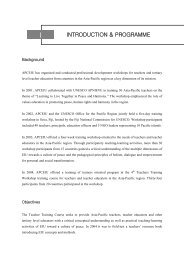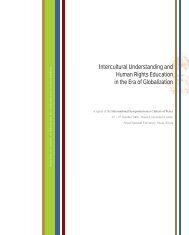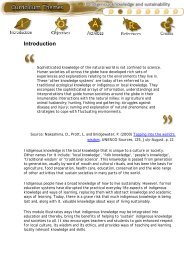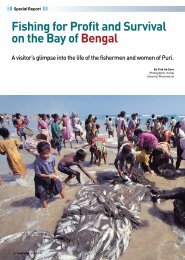REPORT OF UNESCO EXPERT MEETING ON - APCEIU
REPORT OF UNESCO EXPERT MEETING ON - APCEIU
REPORT OF UNESCO EXPERT MEETING ON - APCEIU
You also want an ePaper? Increase the reach of your titles
YUMPU automatically turns print PDFs into web optimized ePapers that Google loves.
willing to shine their light on violations, though this does not always happen since state or corporate<br />
media can often be a central part of power-structures that condone those very violations in the name of<br />
“national interests”, “national security”, or other self-interested geo-strategic agendas.<br />
Secondly, ESD needs to help learners sort through the issue of “universality” versus “relativism” in<br />
understanding and implementing human rights. Although reference is made to recognizing cultural and<br />
social circumstances in the preamble of the Vienna Declaration and Frame of Action adopted by the World<br />
Conference on Human Rights in 1993, nonetheless this Declaration clearly affirms the universality<br />
principle. As human rights advocates and the numerous international conventions and instruments<br />
emphasize, cultural beliefs and practices cannot be used as a rationale to violate human rights. For<br />
example, in some cultures and communities, women can be subject to physical violence in their homes.<br />
Such domestic violence cannot be justified as a culturally specific norm or practice that overrides the<br />
universal rights to security and safety.<br />
Thirdly, educators for a culture of peace and likewise many human rights educators, would suggest that<br />
ESD needs to be especially attentive to the human rights of marginalized and vulnerable groups, including<br />
women, children, refugees and indigenous peoples. Unsustainable development and globalization from<br />
above have , for example, exploited women’s under-paid and socially controlled labour in the global<br />
assembly line and migrant worker sector, while subjecting them to greater hardships in accessing water<br />
and other basic needs. In patriarchal social and cultural systems, men enjoy a greater fulfillment of their<br />
human rights compared to women in almost every social, economic, cultural and political dimensions of<br />
life. Furthermore, ESD needs to highlight and acknowledge the vital role that women have and continue<br />
to struggle to pay in enhancing the sustainable management of resources. Theoretically, ESD can usefully<br />
draw on the insights from the field called eco-feminism, which grounds sustainability principles in<br />
feminist worldviews and perspectives (Reuther, 1992).<br />
Similarly, ESD needs to mobilize advocacy for the rights of children, a group which is increasingly<br />
serving as the most vulnerable and exploited underclass of the unjust world and national economic orders,<br />
whether as street-children, prostitutes or bonded labour. As earlier mentioned, many are also brutally<br />
recruited and traumatized as child soldiers. Another group whose human rights continue to be severely<br />
violated is the refugees and asylum seekers. In this regard, ESD in a nation like Australia necessarily<br />
challenges learners to critically reflect on the consistency of official policies (e.g. mandatory detention of<br />
asylum seeks, even children until recently) with the various human rights conventions to which Australia<br />
is a signatory. In the next theme of educating for a culture of peace, the rights of an often much<br />
marginalized group, namely, indigenous people, will also be examined for the links of education for a<br />
culture of peace with education for sustainability.<br />
Not least, ESD which integrates human rights education also need to ensure that learners understand and<br />
develop commitment to human rights as much as a deep sense of responsibilities. Neglecting this task will<br />
likely lead to a self-centred and egoistic demand for human rights (“mine” or “ours”) with little selfcritical<br />
acknowledgement of being responsible for not violating and helping to act in solidarity in<br />
promoting the human rights of others.<br />
(d) Building Cultural Respect, Reconciliation, and Solidarity<br />
In this theme of educating for a culture of peace, the focus lies on helping learners to critically understand<br />
conflicts between peoples of different cultures and ethnic/“racial” identities. Compounded by a culture of<br />
war and structural violence, these conflicts have included the outcomes of brutal violence even to the<br />
point of genocide and ethnic cleansing. While Samuel Huntington’s thesis of a “clash of civilizations” has<br />
often been cited to “explain “ these conflicts, peace educators and critical multicultural educators would<br />
challenge the thesis as simplistic and dangerously leading to a ‘self-fulfilling prophecy”. This simplistic<br />
argument overlooks the complexities of “civilizations” and ignores the evidence of intercultural<br />
cooperation and solidarity even when conflicts or even wars have occurred. Rather, conflicts involving<br />
communities and peoples of different cultures and traditions are not usually caused by cultural difference<br />
per se, but by a complexity of root political, economic and social causes (e.g. contestation for resources or<br />
territories; struggles for justice and self-determination; political stereotyping in a fear-based post-9/11<br />
national security paradigm).<br />
71








